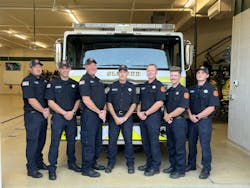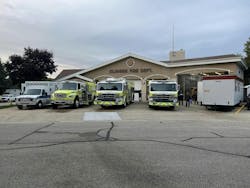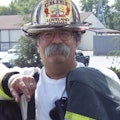Close Calls: Firefighter Down … in the Firehouse
The Slinger, WI, Fire Department (SFD) isn’t that much different than most rural departments in the United States: few serving many, at a time when staffing is a challenge and runs go from the most basic to highly critical, such as in May 2023, when more than 20 fire departments assisted SFD firefighters with a massive fire at a pallet factory.
On July 27, 2024, the members of the volunteer department prepared to respond to one those “ho-hum” runs: a CO alarm activation. One of the members who responded to the station for the call suffered a cardiac emergency after he got behind the wheel of an engine. The calm, cool and immediate response of the stricken firefighter’s fellow members—from the first compression of CPR to transport to the hospital—allowed his comrades to save one of their own.
Our sincere appreciation to SFD Fire Chief Greg Koehler and the members of the SFD, including Capt. Tim Roskopf and Firefighters Zack Bayer, Jason Bohn, Mason Koerber, Brady McMahon and Mathias Schaefer, as well as to Firefighter Jeff Westphal, who reported for what was “just another run” that turned out to be anything but standard.
Cardiac emergency
Westphal responded to the station as driver/motor pump operator of Engine 2164 at approximately 9:00 a.m. for the CO alarm activation in Slinger. He went through his initial steps in advance of moving the apparatus out of the bay, but he never got to the point of shifting the transmission out of park. Sitting in the officer’s seat in the engine with Westphal, Roskopf witnessed Westphal lose consciousness, which was the result of a cardiac emergency.
Roskopf alerted the other members of his crew, and Bayer, Bohn, Koerber, McMahon and Schaefer reacted with zero hesitation. The E2164 team quickly removed Westphal from the rig and assessed him. They determined the need for critical life-saving efforts, including CPR and administration of the fire station’s automated external defibrillator (AED).
After a call to 9-1-1 to request paramedics from LifeStar Ambulance, CPR began within one minute, followed quickly by an AED shock.
(Author’s note: The SFD first-responds on EMS calls; however, ALS and ambulance transportation is provided from LifeStar.)
LifeStar Paramedic Natalia Graff and EMT Nathan Massingale were near to the station at the time of the call for assistance and responded to take over Westphal’s care and to coordinate CPR efforts. Graff provided ALS while CPR continued, including administering several more AED shocks.
Still unresponsive, Westphal was transported quickly to Froedtert West Bend Hospital while paramedics continued to perform CPR on him.
The ambulance’s arrival at the hospital coincided with Westphal experiencing a return of spontaneous circulation, no doubt a result of the CPR efforts and AED intervention. The medical team determined that it was necessary to transfer Westphal to the hospital system’s cardiac care center 22 miles away in Wauwatosa.
Over the next several days, Westphal made remarkable improvements toward recovery. Eight days later, he went home, with no marked deficiencies that were related to a cardiac emergency.
Straightforward, then not
As often can be the case in the fire service, what seems to be “normal” quickly turns into something else, Roskopf recounts. That’s why it’s vital for officers and firefighters to prepare and train as much and in as varied as a way as they can.
“My entire crew jumped in and let their training kick in and started working on [Westphal],” Roskopf says. “We started CPR within the first minute of him going unresponsive.”
That and having an AED in the firehouse and activating the 9-1-1 system led to the saving of Westphal’s life.
“It goes to show how important CPR is and to get trained. You never know when and where you might need to use it,” Roskopf adds. He points out that the five other crewmembers who helped have only a combined 11 years of experience in the fire service.
Initially unwilling to have his story shared, Westphal changed his mind, because he believes that it’s important to get the word out that CPR saves lives.
Furthermore, “I’m thankful for a lot,” he continues. “The guys didn’t hesitate, and I have a new chance to serve again.”
Comments from Goldfeder
“OK, it’s CPR recertification time.”
A groan, whining, etc., often is the reaction, but we do it anyway, because we know that it can matter. It certainly mattered to Westphal.
SFD leaders didn’t have to require CPR training for the department members, but they did. They weren’t required to have an AED, but they obtained one. Westphal probably wouldn’t have survived without the above, but the members had what was needed, and he did survive.
Koehler states that the “system” worked: immediate recognition, trained fire personnel taking action, checking the ABCs, starting CPR, having an AED in the firehouse and activating the 9-1-1 system.
Sadly, only about 46 percent of people who experience an out-of-hospital cardiac arrest receive the immediate help that they need before professional emergency help arrives. Fortunately for Westphal, professionally trained firefighters witnessed his emergency.
The American Heart Association estimates that 100,000–200,000 lives of civilian adults and children could be saved each year if CPR is performed early enough.
There are many ways that a civilian’s life might be saved by members of the fire service—and it’s done every day. When we think about “saving our own,” we justifiably think of working fires and emergency scenes. However, sometimes, it isn’t as dramatic as a rescue from a fire. Sometimes, it’s calm, cool and immediate response, such as how the SFD members were prepared before the event and responded immediately when Westphal went down. From the first compression, their preparedness, which usually is reserved for the public, allowed them to save one of their own.
Slinger Fire Department
The Slinger, WI, Fire Department protects Slinger (population of about 6,500) and the towns of Polk and West Bend, which makes for a total population served of 10,500. Fifty members respond to approximately 200 alarms annually. The department’s fleet includes two engines, a rescue engine, a grass rig, two water tenders, two utility vehicles, a command vehicle, a fire suppression UTV and a rescue boat.
Hands-Only CPR for Witnessed Sudden Collapse
1. Check & Call
- Check the scene, then check the person.
- Tap on the shoulder and shout, “Are you OK?” and quickly look for breathing.
- If no response, call 9-1-1.
- If unresponsive and not breathing, begin chest compressions.
2. Give Chest Compressions
- Place the heel of one hand on the center of the chest.
- Place the heel of the other hand on top of the first hand, lacing your fingers together.
- Keep your arms straight, position your shoulders directly over your hands.
- Push hard, push fast. Compress the chest at least two inches. Compress at least 100 times per minute. Let the chest rise completely before pushing down again.
- Continue chest compressions.
3. Don’t Stop (Except in One of the Following Situations)
- You see an obvious sign of life (breathing).
- Another trained person arrives and takes over.
- EMS personnel arrive and take over.
- You are too exhausted to continue.
- An AED is ready to use.
- The scene becomes unsafe.
Source: American Red Cross
About the Author
Billy Goldfeder
BILLY GOLDFEDER, EFO, who is a Firehouse contributing editor, has been a firefighter since 1973 and a chief officer since 1982. He is deputy fire chief of the Loveland-Symmes Fire Department in Ohio, which is an ISO Class 1, CPSE and CAAS-accredited department. Goldfeder has served on numerous NFPA and International Association of Fire Chiefs (IAFC) committees. He is on the board of directors of the IAFC Safety, Health and Survival Section and the National Fallen Firefighters Foundation.


